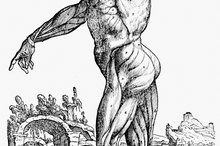How Do Muscles Move the Body's Skeleton?
Muscles are specialized tissues in your body that contain thousands of movable, elastic fibers. A particular type of muscle tissue, called skeletal muscle, is attached to bones throughout your body. When you want to move, your brain sends signals to these muscles and tells them to adjust the position of your underlying skeleton.
Basics
The muscles in your body are connected to your bones by tough, fibrous tissues called tendons. When you move a muscle, the force of this movement passes from the muscle through its associated tendon. The tendon uses this force to initiate movement of the connected bone and associated joint. Together, the muscles, bones and joints involved in this process are commonly referred to as the musculoskeletal system. Most of the muscles and tendons in this system have attachments to the bones in your arms, legs, chest, abdomen, face and neck.
- The muscles in your body are connected to your bones by tough, fibrous tissues called tendons.
- When you move a muscle, the force of this movement passes from the muscle through its associated tendon.
Movement and Coordination
How the Skeletal System Works With Other Body Systems
Learn More
Movements of your musculoskeletal system are typically under your conscious control. When you want to move your body, a portion of your brain called the motor cortex sends an electrical signal to the appropriate muscle through your spinal cord and local nerves. This muscle contracts and initiates movement. As they move, the muscle and its associated joint send feedback signals up through your nerves to a section of your brain called the cerebellum. Together, the outward and inward nerve signals passing between your brain and musculoskeletal system give you the ability to coordinate and fine-tune your body’s movements and position.
- Movements of your musculoskeletal system are typically under your conscious control.
- When you want to move your body, a portion of your brain called the motor cortex sends an electrical signal to the appropriate muscle through your spinal cord and local nerves.
Flexors and Extensors
When they contract during movement, your muscles can only pull your bones in a single direction. If you want to return your body to its original position, the muscles that performed the initial movement can’t help you achieve this objective. To overcome this problem, your musculoskeletal system uses another set of associated muscles that contract in the opposite direction and pull your body back into place. The muscles in your body that pull your limbs into a bent position are commonly referred to as flexors; the muscles that straighten your limbs are commonly referred to as extensors.
- When they contract during movement, your muscles can only pull your bones in a single direction.
Considerations
What Are the Names of the Muscles in the Arm & Shoulder?
Learn More
Not all the muscles in your body belong to your musculoskeletal system or help provide skeletal movement. Specialized muscles in your body’s interior, called smooth muscles, perform vital involuntary tasks, including moving food and wastes through your digestive system and adjusting the blood flow in arteries throughout your body. Your heart is formed from another type of specialized muscle tissue, called cardiac tissue or the myocardium.
Related Articles
References
Writer Bio
M. Gideon Hoyle is a writer living outside of Houston. Previously, he produced brochures and a wide variety of other materials for a nonprofit educational foundation. He now specializes in topics related to health, exercise and nutrition, publishing for various websites.






